Essay: Information Systems and ERP in Business Operations
VerifiedAdded on 2023/01/17
|11
|2966
|67
Essay
AI Summary
This essay delves into the significance of information systems and their pivotal role in contemporary business operations. It begins by defining information systems and highlighting their importance in data collection, storage, and dissemination for effective decision-making. The essay explores various types of information systems, including Decision Support Systems (DSS), Management Information Systems (MIS), and Transaction Processing Systems (TPS), illustrating their functions within an organizational hierarchy. A major focus is placed on Enterprise Resource Planning (ERP) systems, detailing their architecture, benefits, and practical applications. The essay emphasizes how ERP systems integrate various business functions, streamline processes, enhance decision-making, and ultimately contribute to improved organizational performance. The conclusion underscores the necessity of information systems for businesses of all sizes and offers recommendations for optimizing ERP utilization.
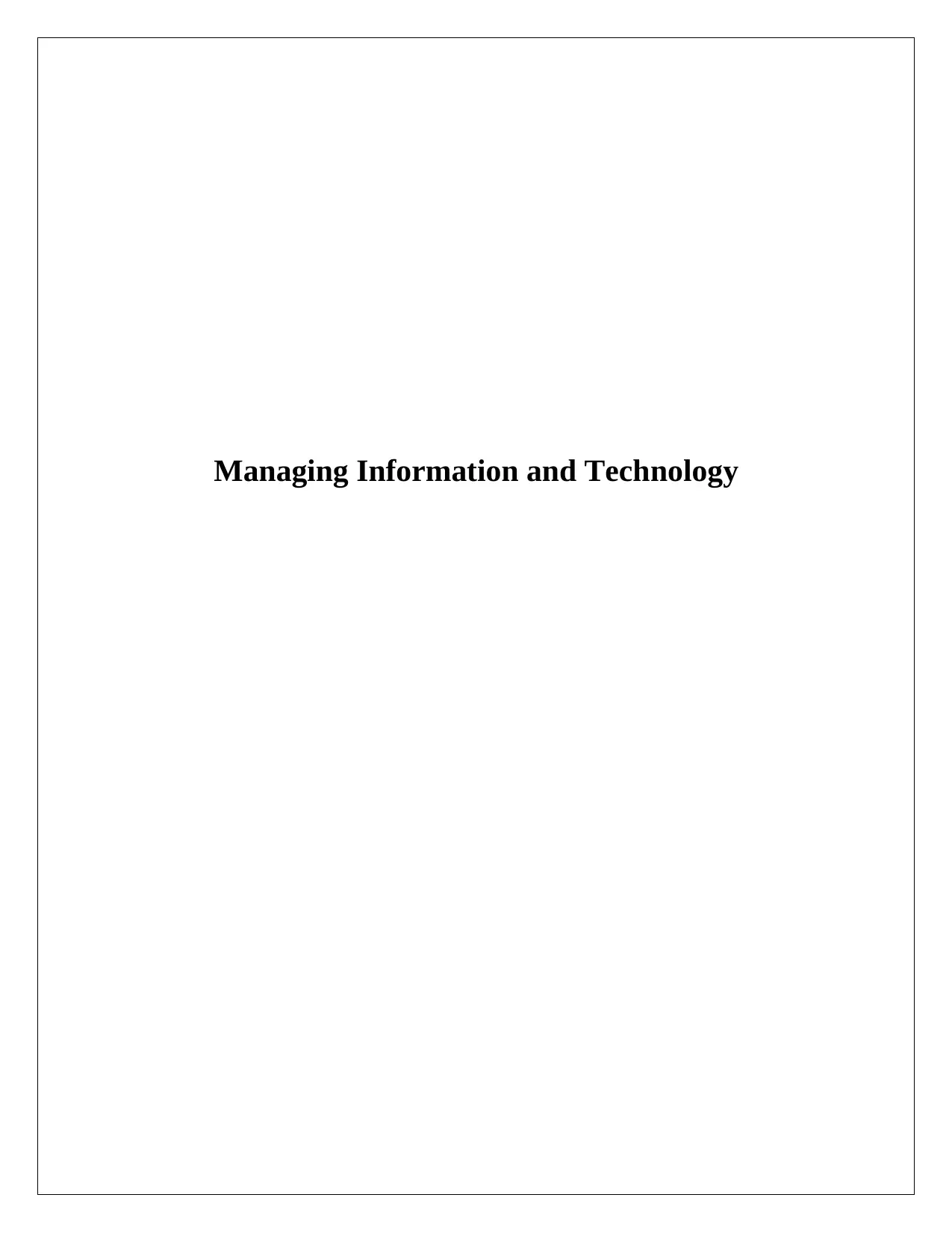
Managing Information and Technology
Paraphrase This Document
Need a fresh take? Get an instant paraphrase of this document with our AI Paraphraser
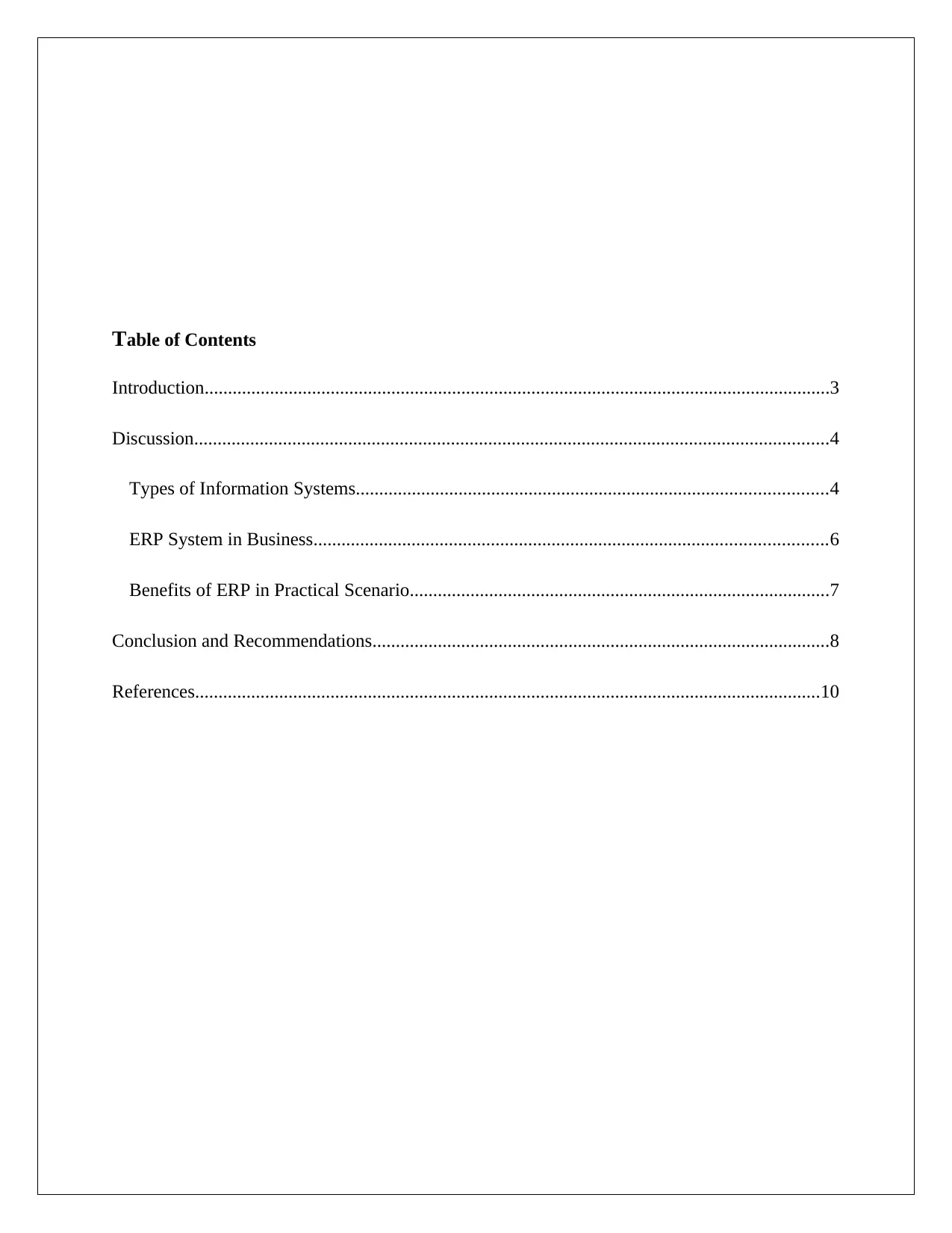
Table of Contents
Introduction......................................................................................................................................3
Discussion........................................................................................................................................4
Types of Information Systems.....................................................................................................4
ERP System in Business..............................................................................................................6
Benefits of ERP in Practical Scenario..........................................................................................7
Conclusion and Recommendations..................................................................................................8
References......................................................................................................................................10
Introduction......................................................................................................................................3
Discussion........................................................................................................................................4
Types of Information Systems.....................................................................................................4
ERP System in Business..............................................................................................................6
Benefits of ERP in Practical Scenario..........................................................................................7
Conclusion and Recommendations..................................................................................................8
References......................................................................................................................................10
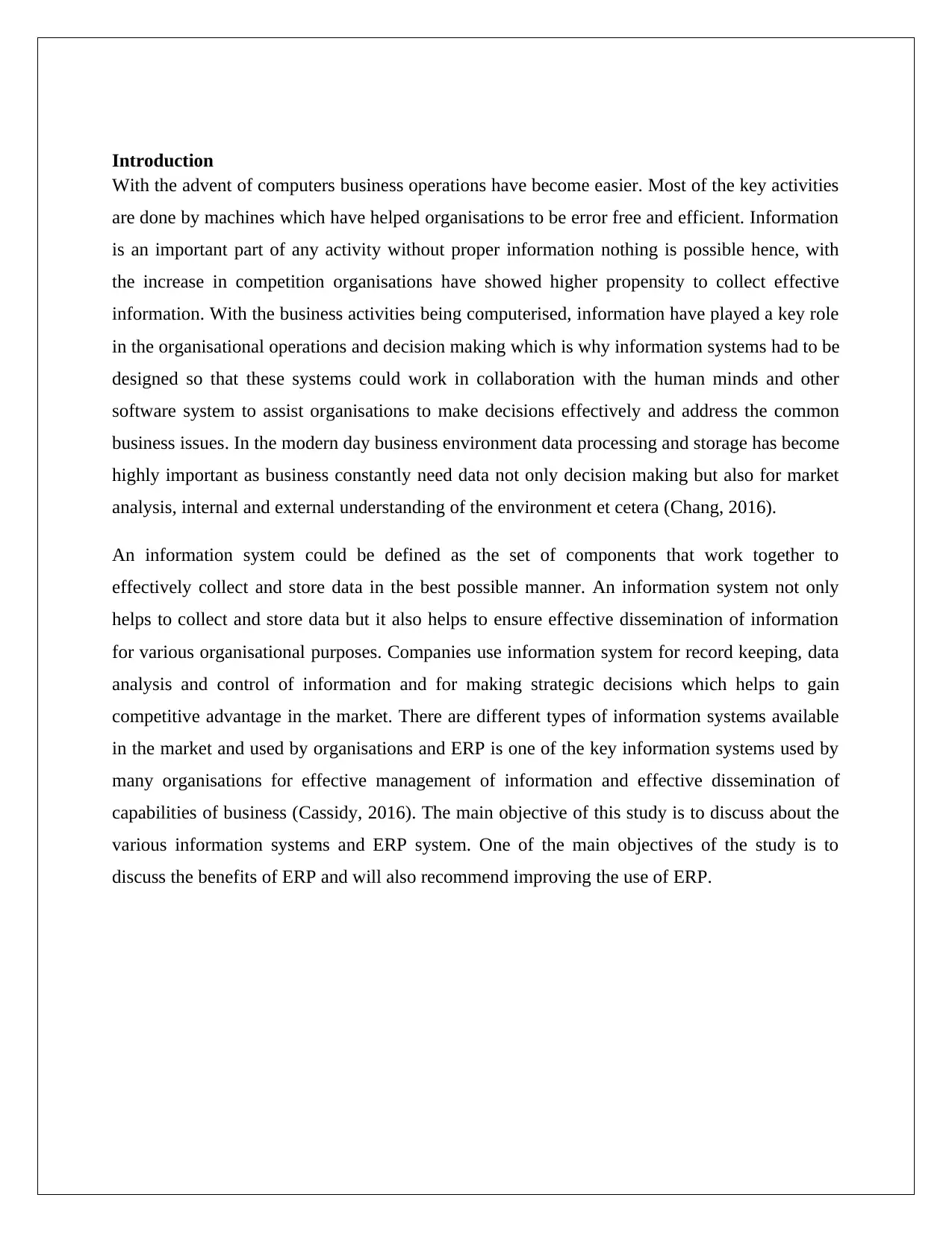
Introduction
With the advent of computers business operations have become easier. Most of the key activities
are done by machines which have helped organisations to be error free and efficient. Information
is an important part of any activity without proper information nothing is possible hence, with
the increase in competition organisations have showed higher propensity to collect effective
information. With the business activities being computerised, information have played a key role
in the organisational operations and decision making which is why information systems had to be
designed so that these systems could work in collaboration with the human minds and other
software system to assist organisations to make decisions effectively and address the common
business issues. In the modern day business environment data processing and storage has become
highly important as business constantly need data not only decision making but also for market
analysis, internal and external understanding of the environment et cetera (Chang, 2016).
An information system could be defined as the set of components that work together to
effectively collect and store data in the best possible manner. An information system not only
helps to collect and store data but it also helps to ensure effective dissemination of information
for various organisational purposes. Companies use information system for record keeping, data
analysis and control of information and for making strategic decisions which helps to gain
competitive advantage in the market. There are different types of information systems available
in the market and used by organisations and ERP is one of the key information systems used by
many organisations for effective management of information and effective dissemination of
capabilities of business (Cassidy, 2016). The main objective of this study is to discuss about the
various information systems and ERP system. One of the main objectives of the study is to
discuss the benefits of ERP and will also recommend improving the use of ERP.
With the advent of computers business operations have become easier. Most of the key activities
are done by machines which have helped organisations to be error free and efficient. Information
is an important part of any activity without proper information nothing is possible hence, with
the increase in competition organisations have showed higher propensity to collect effective
information. With the business activities being computerised, information have played a key role
in the organisational operations and decision making which is why information systems had to be
designed so that these systems could work in collaboration with the human minds and other
software system to assist organisations to make decisions effectively and address the common
business issues. In the modern day business environment data processing and storage has become
highly important as business constantly need data not only decision making but also for market
analysis, internal and external understanding of the environment et cetera (Chang, 2016).
An information system could be defined as the set of components that work together to
effectively collect and store data in the best possible manner. An information system not only
helps to collect and store data but it also helps to ensure effective dissemination of information
for various organisational purposes. Companies use information system for record keeping, data
analysis and control of information and for making strategic decisions which helps to gain
competitive advantage in the market. There are different types of information systems available
in the market and used by organisations and ERP is one of the key information systems used by
many organisations for effective management of information and effective dissemination of
capabilities of business (Cassidy, 2016). The main objective of this study is to discuss about the
various information systems and ERP system. One of the main objectives of the study is to
discuss the benefits of ERP and will also recommend improving the use of ERP.
⊘ This is a preview!⊘
Do you want full access?
Subscribe today to unlock all pages.

Trusted by 1+ million students worldwide
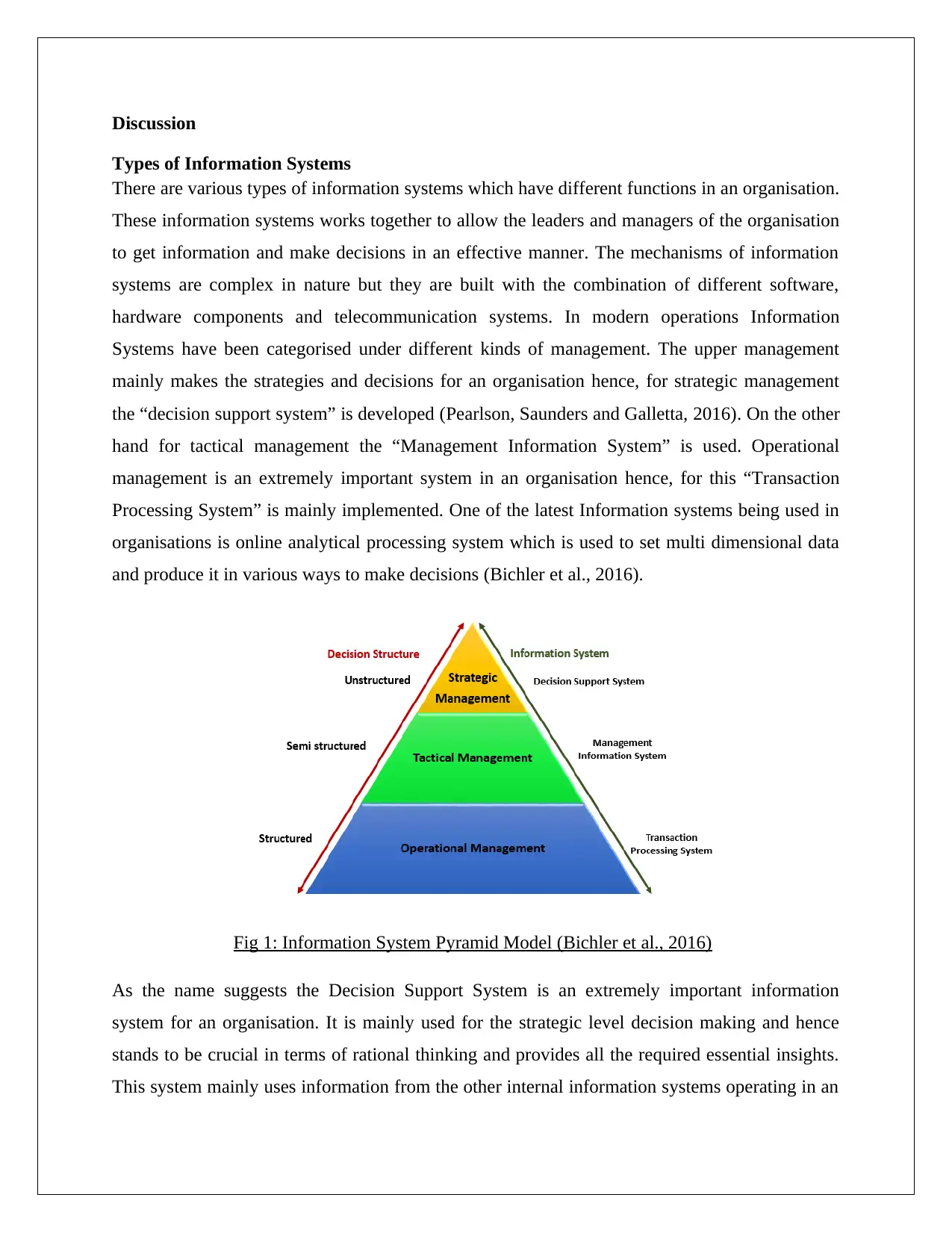
Discussion
Types of Information Systems
There are various types of information systems which have different functions in an organisation.
These information systems works together to allow the leaders and managers of the organisation
to get information and make decisions in an effective manner. The mechanisms of information
systems are complex in nature but they are built with the combination of different software,
hardware components and telecommunication systems. In modern operations Information
Systems have been categorised under different kinds of management. The upper management
mainly makes the strategies and decisions for an organisation hence, for strategic management
the “decision support system” is developed (Pearlson, Saunders and Galletta, 2016). On the other
hand for tactical management the “Management Information System” is used. Operational
management is an extremely important system in an organisation hence, for this “Transaction
Processing System” is mainly implemented. One of the latest Information systems being used in
organisations is online analytical processing system which is used to set multi dimensional data
and produce it in various ways to make decisions (Bichler et al., 2016).
Fig 1: Information System Pyramid Model (Bichler et al., 2016)
As the name suggests the Decision Support System is an extremely important information
system for an organisation. It is mainly used for the strategic level decision making and hence
stands to be crucial in terms of rational thinking and provides all the required essential insights.
This system mainly uses information from the other internal information systems operating in an
Types of Information Systems
There are various types of information systems which have different functions in an organisation.
These information systems works together to allow the leaders and managers of the organisation
to get information and make decisions in an effective manner. The mechanisms of information
systems are complex in nature but they are built with the combination of different software,
hardware components and telecommunication systems. In modern operations Information
Systems have been categorised under different kinds of management. The upper management
mainly makes the strategies and decisions for an organisation hence, for strategic management
the “decision support system” is developed (Pearlson, Saunders and Galletta, 2016). On the other
hand for tactical management the “Management Information System” is used. Operational
management is an extremely important system in an organisation hence, for this “Transaction
Processing System” is mainly implemented. One of the latest Information systems being used in
organisations is online analytical processing system which is used to set multi dimensional data
and produce it in various ways to make decisions (Bichler et al., 2016).
Fig 1: Information System Pyramid Model (Bichler et al., 2016)
As the name suggests the Decision Support System is an extremely important information
system for an organisation. It is mainly used for the strategic level decision making and hence
stands to be crucial in terms of rational thinking and provides all the required essential insights.
This system mainly uses information from the other internal information systems operating in an
Paraphrase This Document
Need a fresh take? Get an instant paraphrase of this document with our AI Paraphraser
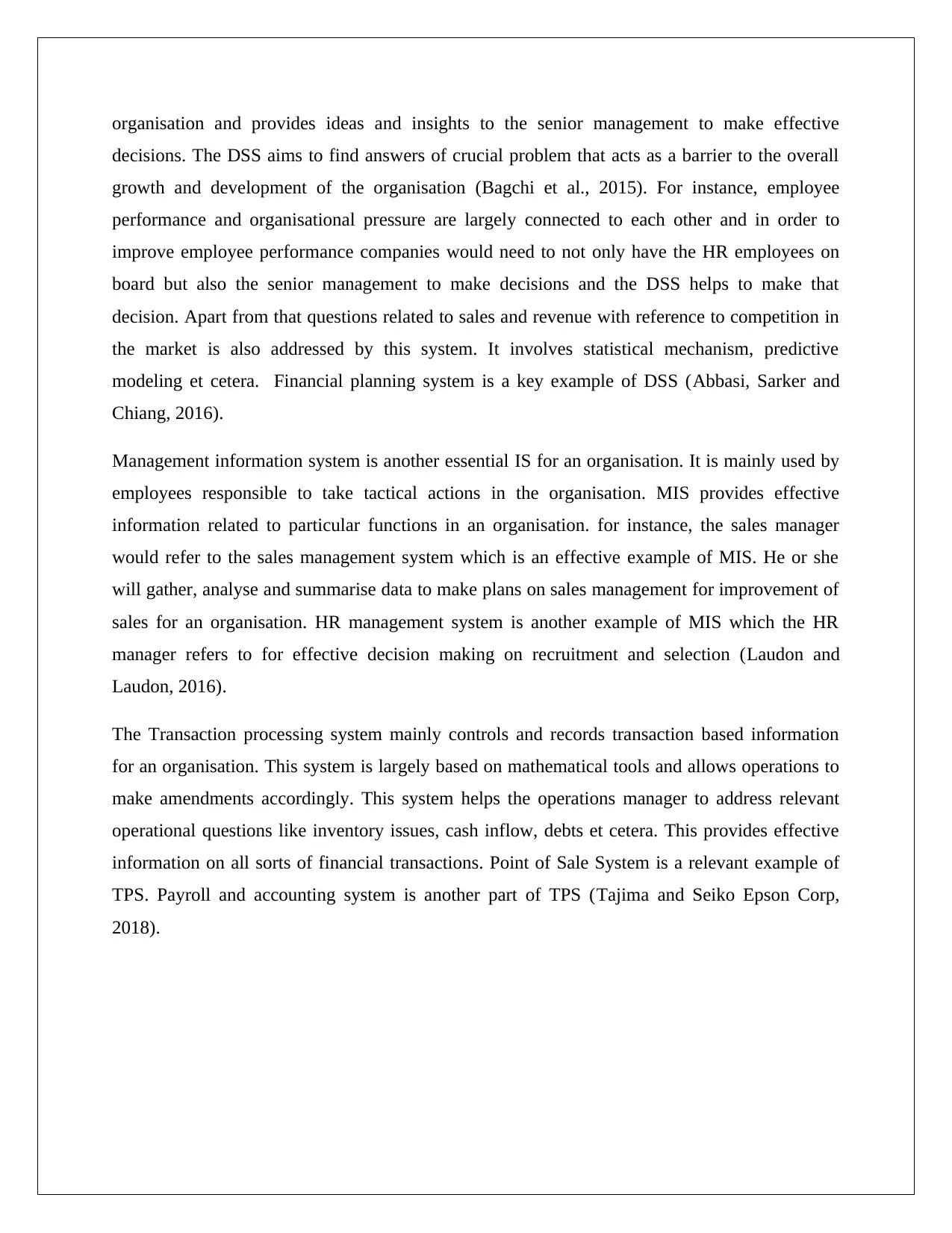
organisation and provides ideas and insights to the senior management to make effective
decisions. The DSS aims to find answers of crucial problem that acts as a barrier to the overall
growth and development of the organisation (Bagchi et al., 2015). For instance, employee
performance and organisational pressure are largely connected to each other and in order to
improve employee performance companies would need to not only have the HR employees on
board but also the senior management to make decisions and the DSS helps to make that
decision. Apart from that questions related to sales and revenue with reference to competition in
the market is also addressed by this system. It involves statistical mechanism, predictive
modeling et cetera. Financial planning system is a key example of DSS (Abbasi, Sarker and
Chiang, 2016).
Management information system is another essential IS for an organisation. It is mainly used by
employees responsible to take tactical actions in the organisation. MIS provides effective
information related to particular functions in an organisation. for instance, the sales manager
would refer to the sales management system which is an effective example of MIS. He or she
will gather, analyse and summarise data to make plans on sales management for improvement of
sales for an organisation. HR management system is another example of MIS which the HR
manager refers to for effective decision making on recruitment and selection (Laudon and
Laudon, 2016).
The Transaction processing system mainly controls and records transaction based information
for an organisation. This system is largely based on mathematical tools and allows operations to
make amendments accordingly. This system helps the operations manager to address relevant
operational questions like inventory issues, cash inflow, debts et cetera. This provides effective
information on all sorts of financial transactions. Point of Sale System is a relevant example of
TPS. Payroll and accounting system is another part of TPS (Tajima and Seiko Epson Corp,
2018).
decisions. The DSS aims to find answers of crucial problem that acts as a barrier to the overall
growth and development of the organisation (Bagchi et al., 2015). For instance, employee
performance and organisational pressure are largely connected to each other and in order to
improve employee performance companies would need to not only have the HR employees on
board but also the senior management to make decisions and the DSS helps to make that
decision. Apart from that questions related to sales and revenue with reference to competition in
the market is also addressed by this system. It involves statistical mechanism, predictive
modeling et cetera. Financial planning system is a key example of DSS (Abbasi, Sarker and
Chiang, 2016).
Management information system is another essential IS for an organisation. It is mainly used by
employees responsible to take tactical actions in the organisation. MIS provides effective
information related to particular functions in an organisation. for instance, the sales manager
would refer to the sales management system which is an effective example of MIS. He or she
will gather, analyse and summarise data to make plans on sales management for improvement of
sales for an organisation. HR management system is another example of MIS which the HR
manager refers to for effective decision making on recruitment and selection (Laudon and
Laudon, 2016).
The Transaction processing system mainly controls and records transaction based information
for an organisation. This system is largely based on mathematical tools and allows operations to
make amendments accordingly. This system helps the operations manager to address relevant
operational questions like inventory issues, cash inflow, debts et cetera. This provides effective
information on all sorts of financial transactions. Point of Sale System is a relevant example of
TPS. Payroll and accounting system is another part of TPS (Tajima and Seiko Epson Corp,
2018).
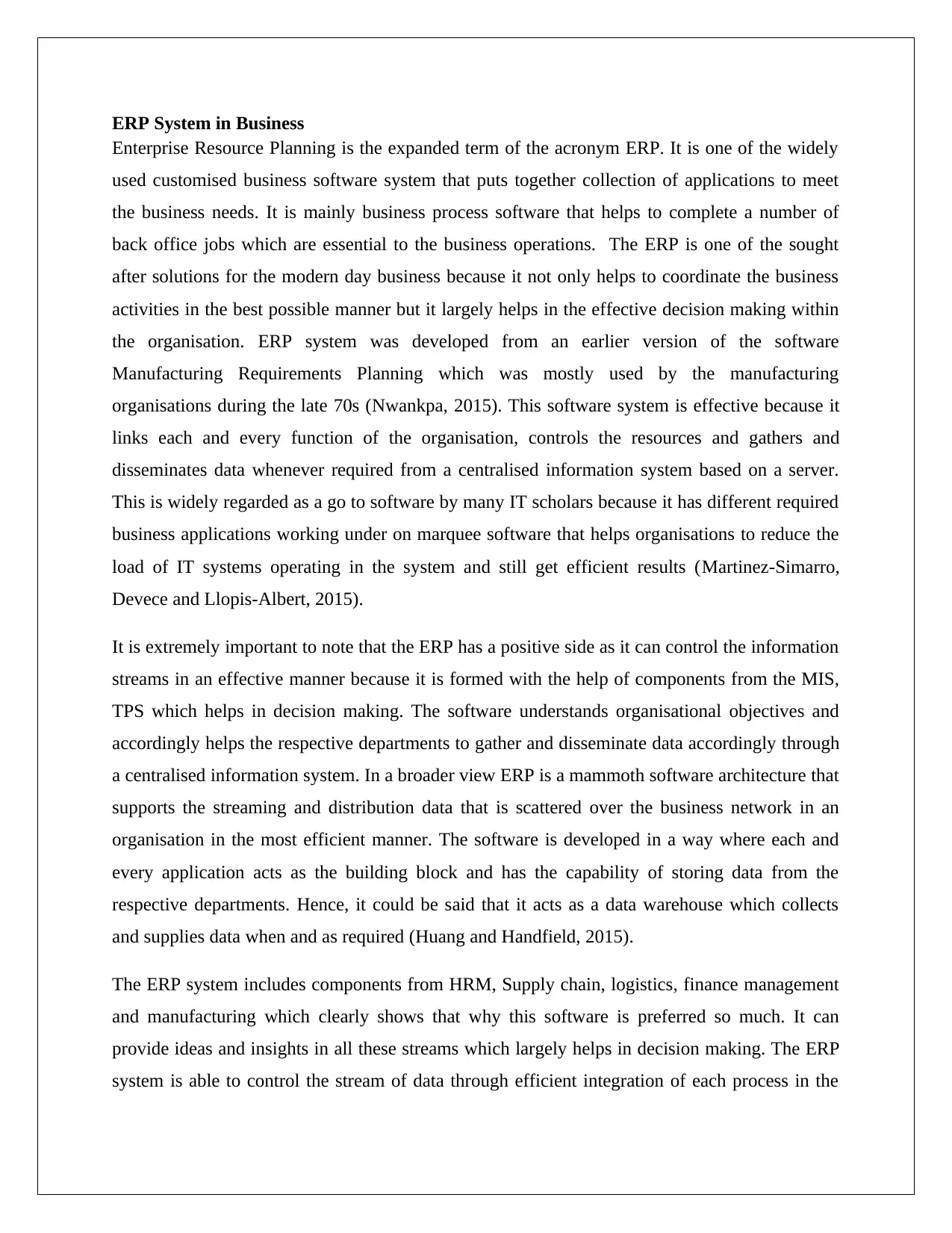
ERP System in Business
Enterprise Resource Planning is the expanded term of the acronym ERP. It is one of the widely
used customised business software system that puts together collection of applications to meet
the business needs. It is mainly business process software that helps to complete a number of
back office jobs which are essential to the business operations. The ERP is one of the sought
after solutions for the modern day business because it not only helps to coordinate the business
activities in the best possible manner but it largely helps in the effective decision making within
the organisation. ERP system was developed from an earlier version of the software
Manufacturing Requirements Planning which was mostly used by the manufacturing
organisations during the late 70s (Nwankpa, 2015). This software system is effective because it
links each and every function of the organisation, controls the resources and gathers and
disseminates data whenever required from a centralised information system based on a server.
This is widely regarded as a go to software by many IT scholars because it has different required
business applications working under on marquee software that helps organisations to reduce the
load of IT systems operating in the system and still get efficient results (Martinez-Simarro,
Devece and Llopis-Albert, 2015).
It is extremely important to note that the ERP has a positive side as it can control the information
streams in an effective manner because it is formed with the help of components from the MIS,
TPS which helps in decision making. The software understands organisational objectives and
accordingly helps the respective departments to gather and disseminate data accordingly through
a centralised information system. In a broader view ERP is a mammoth software architecture that
supports the streaming and distribution data that is scattered over the business network in an
organisation in the most efficient manner. The software is developed in a way where each and
every application acts as the building block and has the capability of storing data from the
respective departments. Hence, it could be said that it acts as a data warehouse which collects
and supplies data when and as required (Huang and Handfield, 2015).
The ERP system includes components from HRM, Supply chain, logistics, finance management
and manufacturing which clearly shows that why this software is preferred so much. It can
provide ideas and insights in all these streams which largely helps in decision making. The ERP
system is able to control the stream of data through efficient integration of each process in the
Enterprise Resource Planning is the expanded term of the acronym ERP. It is one of the widely
used customised business software system that puts together collection of applications to meet
the business needs. It is mainly business process software that helps to complete a number of
back office jobs which are essential to the business operations. The ERP is one of the sought
after solutions for the modern day business because it not only helps to coordinate the business
activities in the best possible manner but it largely helps in the effective decision making within
the organisation. ERP system was developed from an earlier version of the software
Manufacturing Requirements Planning which was mostly used by the manufacturing
organisations during the late 70s (Nwankpa, 2015). This software system is effective because it
links each and every function of the organisation, controls the resources and gathers and
disseminates data whenever required from a centralised information system based on a server.
This is widely regarded as a go to software by many IT scholars because it has different required
business applications working under on marquee software that helps organisations to reduce the
load of IT systems operating in the system and still get efficient results (Martinez-Simarro,
Devece and Llopis-Albert, 2015).
It is extremely important to note that the ERP has a positive side as it can control the information
streams in an effective manner because it is formed with the help of components from the MIS,
TPS which helps in decision making. The software understands organisational objectives and
accordingly helps the respective departments to gather and disseminate data accordingly through
a centralised information system. In a broader view ERP is a mammoth software architecture that
supports the streaming and distribution data that is scattered over the business network in an
organisation in the most efficient manner. The software is developed in a way where each and
every application acts as the building block and has the capability of storing data from the
respective departments. Hence, it could be said that it acts as a data warehouse which collects
and supplies data when and as required (Huang and Handfield, 2015).
The ERP system includes components from HRM, Supply chain, logistics, finance management
and manufacturing which clearly shows that why this software is preferred so much. It can
provide ideas and insights in all these streams which largely helps in decision making. The ERP
system is able to control the stream of data through efficient integration of each process in the
⊘ This is a preview!⊘
Do you want full access?
Subscribe today to unlock all pages.

Trusted by 1+ million students worldwide
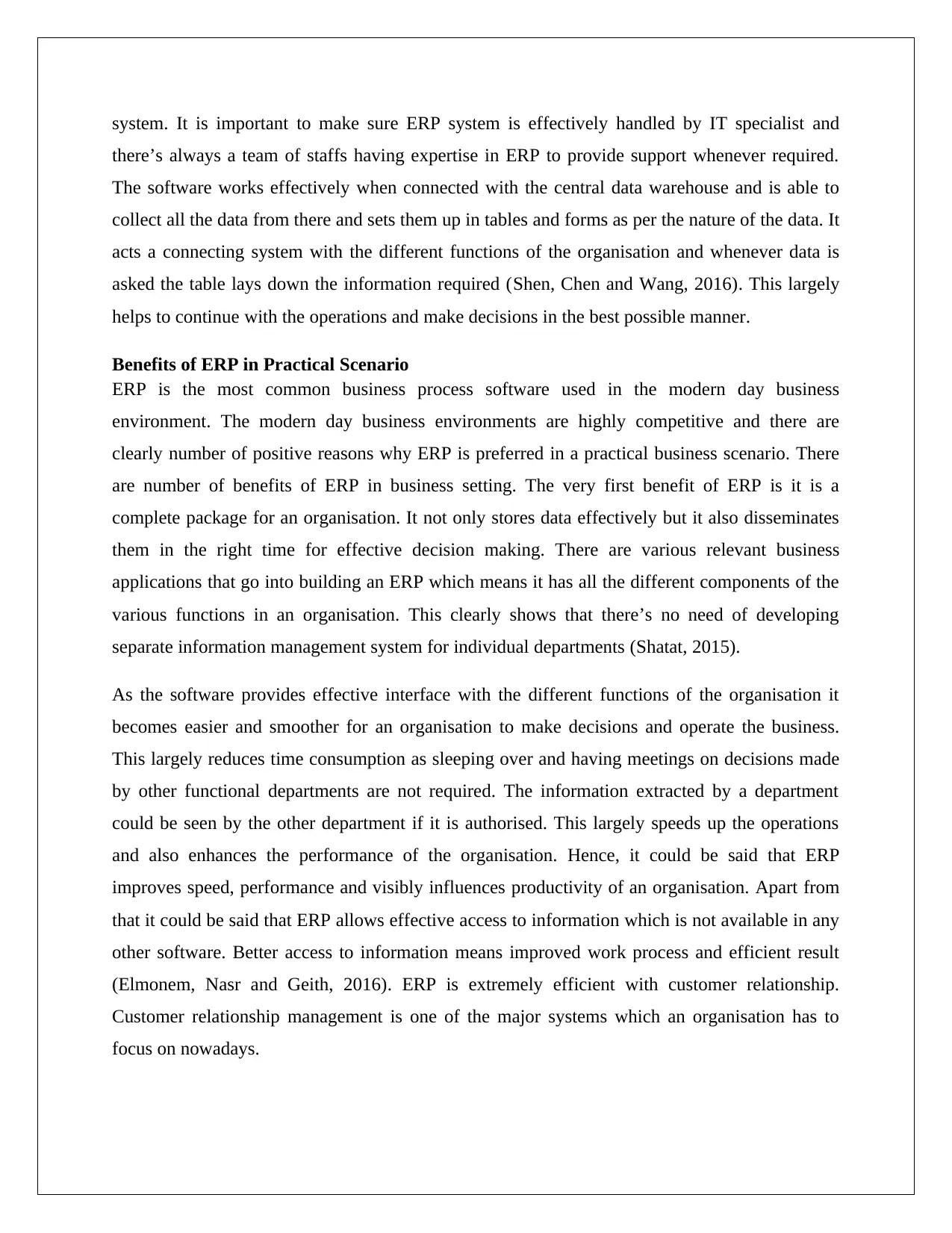
system. It is important to make sure ERP system is effectively handled by IT specialist and
there’s always a team of staffs having expertise in ERP to provide support whenever required.
The software works effectively when connected with the central data warehouse and is able to
collect all the data from there and sets them up in tables and forms as per the nature of the data. It
acts a connecting system with the different functions of the organisation and whenever data is
asked the table lays down the information required (Shen, Chen and Wang, 2016). This largely
helps to continue with the operations and make decisions in the best possible manner.
Benefits of ERP in Practical Scenario
ERP is the most common business process software used in the modern day business
environment. The modern day business environments are highly competitive and there are
clearly number of positive reasons why ERP is preferred in a practical business scenario. There
are number of benefits of ERP in business setting. The very first benefit of ERP is it is a
complete package for an organisation. It not only stores data effectively but it also disseminates
them in the right time for effective decision making. There are various relevant business
applications that go into building an ERP which means it has all the different components of the
various functions in an organisation. This clearly shows that there’s no need of developing
separate information management system for individual departments (Shatat, 2015).
As the software provides effective interface with the different functions of the organisation it
becomes easier and smoother for an organisation to make decisions and operate the business.
This largely reduces time consumption as sleeping over and having meetings on decisions made
by other functional departments are not required. The information extracted by a department
could be seen by the other department if it is authorised. This largely speeds up the operations
and also enhances the performance of the organisation. Hence, it could be said that ERP
improves speed, performance and visibly influences productivity of an organisation. Apart from
that it could be said that ERP allows effective access to information which is not available in any
other software. Better access to information means improved work process and efficient result
(Elmonem, Nasr and Geith, 2016). ERP is extremely efficient with customer relationship.
Customer relationship management is one of the major systems which an organisation has to
focus on nowadays.
there’s always a team of staffs having expertise in ERP to provide support whenever required.
The software works effectively when connected with the central data warehouse and is able to
collect all the data from there and sets them up in tables and forms as per the nature of the data. It
acts a connecting system with the different functions of the organisation and whenever data is
asked the table lays down the information required (Shen, Chen and Wang, 2016). This largely
helps to continue with the operations and make decisions in the best possible manner.
Benefits of ERP in Practical Scenario
ERP is the most common business process software used in the modern day business
environment. The modern day business environments are highly competitive and there are
clearly number of positive reasons why ERP is preferred in a practical business scenario. There
are number of benefits of ERP in business setting. The very first benefit of ERP is it is a
complete package for an organisation. It not only stores data effectively but it also disseminates
them in the right time for effective decision making. There are various relevant business
applications that go into building an ERP which means it has all the different components of the
various functions in an organisation. This clearly shows that there’s no need of developing
separate information management system for individual departments (Shatat, 2015).
As the software provides effective interface with the different functions of the organisation it
becomes easier and smoother for an organisation to make decisions and operate the business.
This largely reduces time consumption as sleeping over and having meetings on decisions made
by other functional departments are not required. The information extracted by a department
could be seen by the other department if it is authorised. This largely speeds up the operations
and also enhances the performance of the organisation. Hence, it could be said that ERP
improves speed, performance and visibly influences productivity of an organisation. Apart from
that it could be said that ERP allows effective access to information which is not available in any
other software. Better access to information means improved work process and efficient result
(Elmonem, Nasr and Geith, 2016). ERP is extremely efficient with customer relationship.
Customer relationship management is one of the major systems which an organisation has to
focus on nowadays.
Paraphrase This Document
Need a fresh take? Get an instant paraphrase of this document with our AI Paraphraser
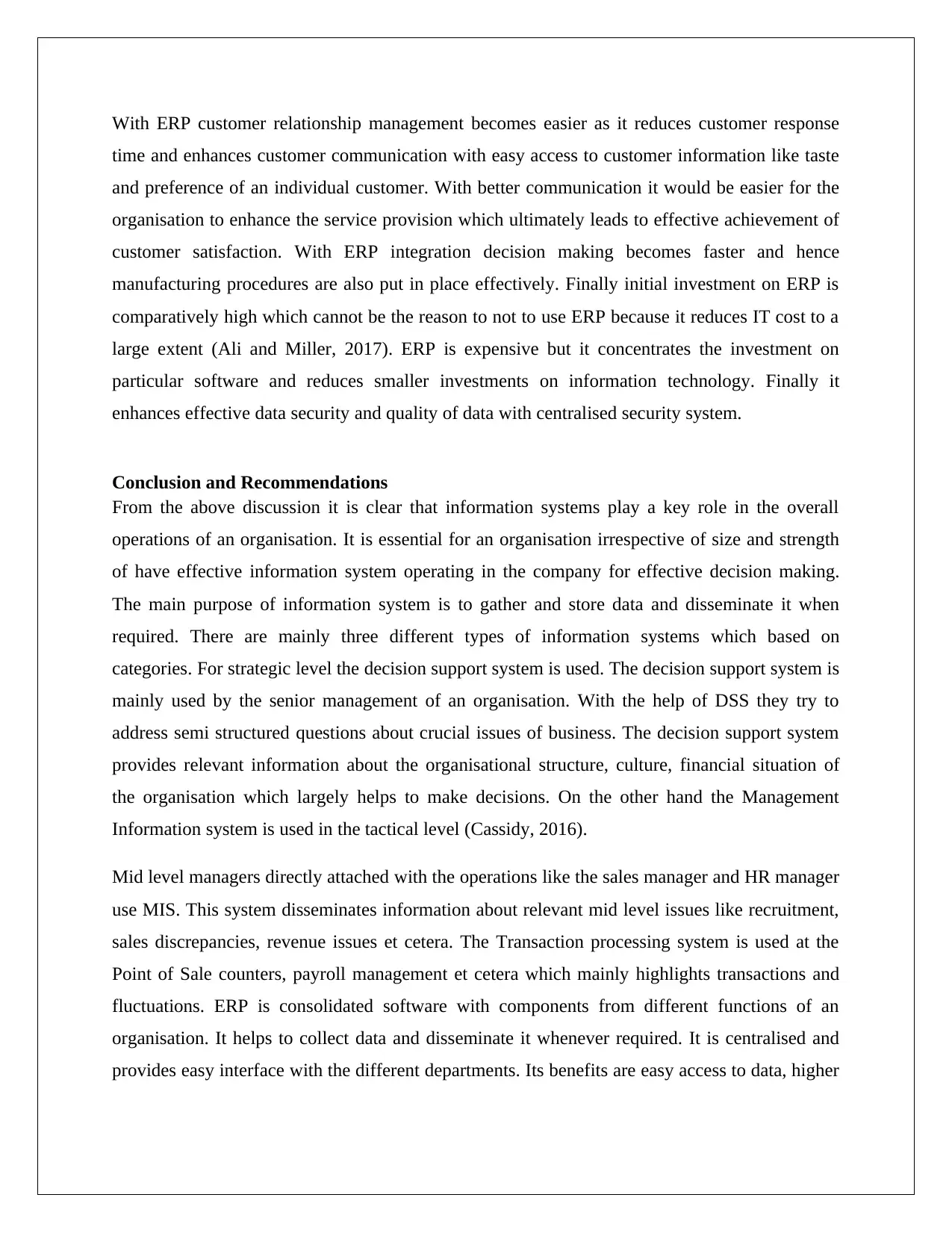
With ERP customer relationship management becomes easier as it reduces customer response
time and enhances customer communication with easy access to customer information like taste
and preference of an individual customer. With better communication it would be easier for the
organisation to enhance the service provision which ultimately leads to effective achievement of
customer satisfaction. With ERP integration decision making becomes faster and hence
manufacturing procedures are also put in place effectively. Finally initial investment on ERP is
comparatively high which cannot be the reason to not to use ERP because it reduces IT cost to a
large extent (Ali and Miller, 2017). ERP is expensive but it concentrates the investment on
particular software and reduces smaller investments on information technology. Finally it
enhances effective data security and quality of data with centralised security system.
Conclusion and Recommendations
From the above discussion it is clear that information systems play a key role in the overall
operations of an organisation. It is essential for an organisation irrespective of size and strength
of have effective information system operating in the company for effective decision making.
The main purpose of information system is to gather and store data and disseminate it when
required. There are mainly three different types of information systems which based on
categories. For strategic level the decision support system is used. The decision support system is
mainly used by the senior management of an organisation. With the help of DSS they try to
address semi structured questions about crucial issues of business. The decision support system
provides relevant information about the organisational structure, culture, financial situation of
the organisation which largely helps to make decisions. On the other hand the Management
Information system is used in the tactical level (Cassidy, 2016).
Mid level managers directly attached with the operations like the sales manager and HR manager
use MIS. This system disseminates information about relevant mid level issues like recruitment,
sales discrepancies, revenue issues et cetera. The Transaction processing system is used at the
Point of Sale counters, payroll management et cetera which mainly highlights transactions and
fluctuations. ERP is consolidated software with components from different functions of an
organisation. It helps to collect data and disseminate it whenever required. It is centralised and
provides easy interface with the different departments. Its benefits are easy access to data, higher
time and enhances customer communication with easy access to customer information like taste
and preference of an individual customer. With better communication it would be easier for the
organisation to enhance the service provision which ultimately leads to effective achievement of
customer satisfaction. With ERP integration decision making becomes faster and hence
manufacturing procedures are also put in place effectively. Finally initial investment on ERP is
comparatively high which cannot be the reason to not to use ERP because it reduces IT cost to a
large extent (Ali and Miller, 2017). ERP is expensive but it concentrates the investment on
particular software and reduces smaller investments on information technology. Finally it
enhances effective data security and quality of data with centralised security system.
Conclusion and Recommendations
From the above discussion it is clear that information systems play a key role in the overall
operations of an organisation. It is essential for an organisation irrespective of size and strength
of have effective information system operating in the company for effective decision making.
The main purpose of information system is to gather and store data and disseminate it when
required. There are mainly three different types of information systems which based on
categories. For strategic level the decision support system is used. The decision support system is
mainly used by the senior management of an organisation. With the help of DSS they try to
address semi structured questions about crucial issues of business. The decision support system
provides relevant information about the organisational structure, culture, financial situation of
the organisation which largely helps to make decisions. On the other hand the Management
Information system is used in the tactical level (Cassidy, 2016).
Mid level managers directly attached with the operations like the sales manager and HR manager
use MIS. This system disseminates information about relevant mid level issues like recruitment,
sales discrepancies, revenue issues et cetera. The Transaction processing system is used at the
Point of Sale counters, payroll management et cetera which mainly highlights transactions and
fluctuations. ERP is consolidated software with components from different functions of an
organisation. It helps to collect data and disseminate it whenever required. It is centralised and
provides easy interface with the different departments. Its benefits are easy access to data, higher
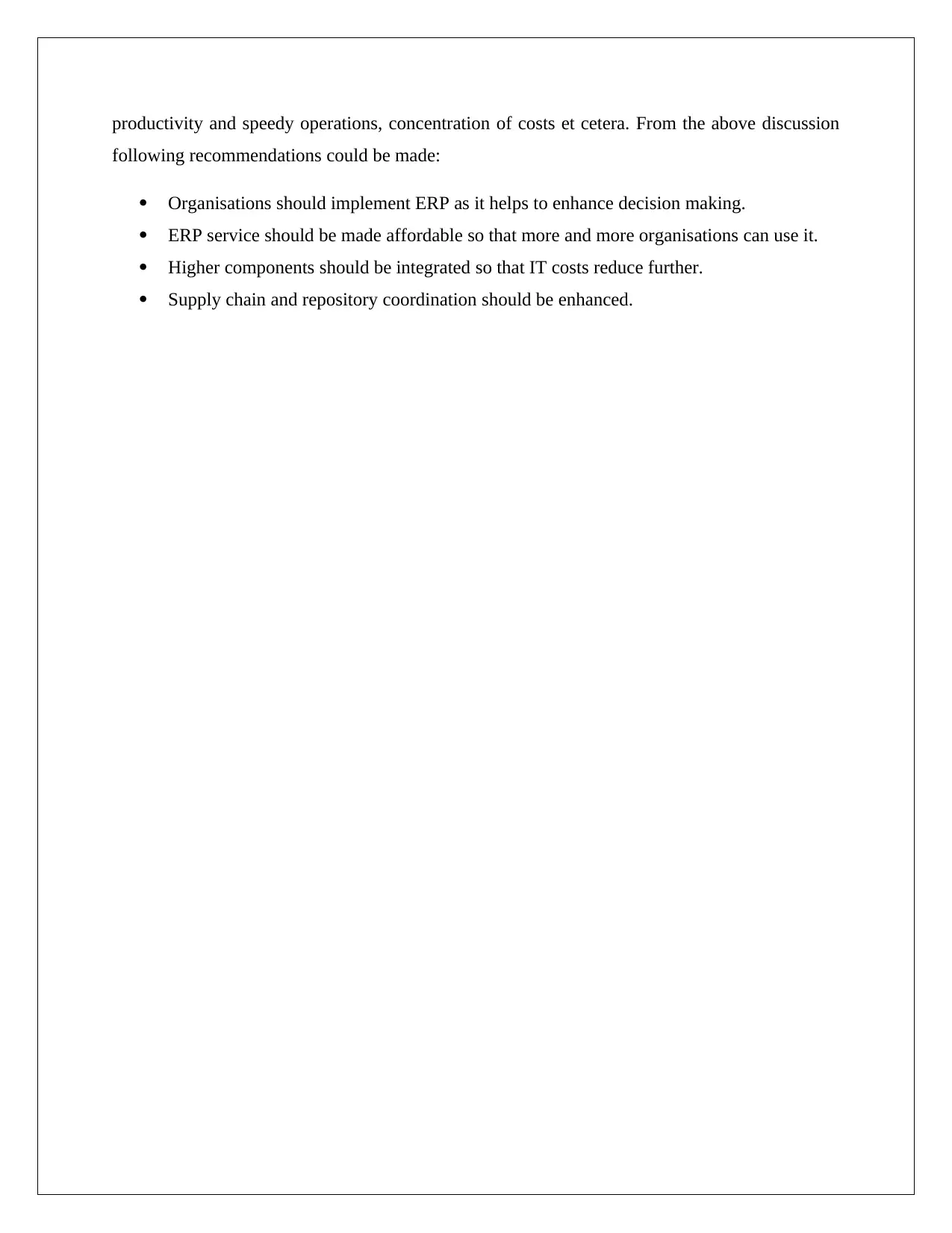
productivity and speedy operations, concentration of costs et cetera. From the above discussion
following recommendations could be made:
Organisations should implement ERP as it helps to enhance decision making.
ERP service should be made affordable so that more and more organisations can use it.
Higher components should be integrated so that IT costs reduce further.
Supply chain and repository coordination should be enhanced.
following recommendations could be made:
Organisations should implement ERP as it helps to enhance decision making.
ERP service should be made affordable so that more and more organisations can use it.
Higher components should be integrated so that IT costs reduce further.
Supply chain and repository coordination should be enhanced.
⊘ This is a preview!⊘
Do you want full access?
Subscribe today to unlock all pages.

Trusted by 1+ million students worldwide
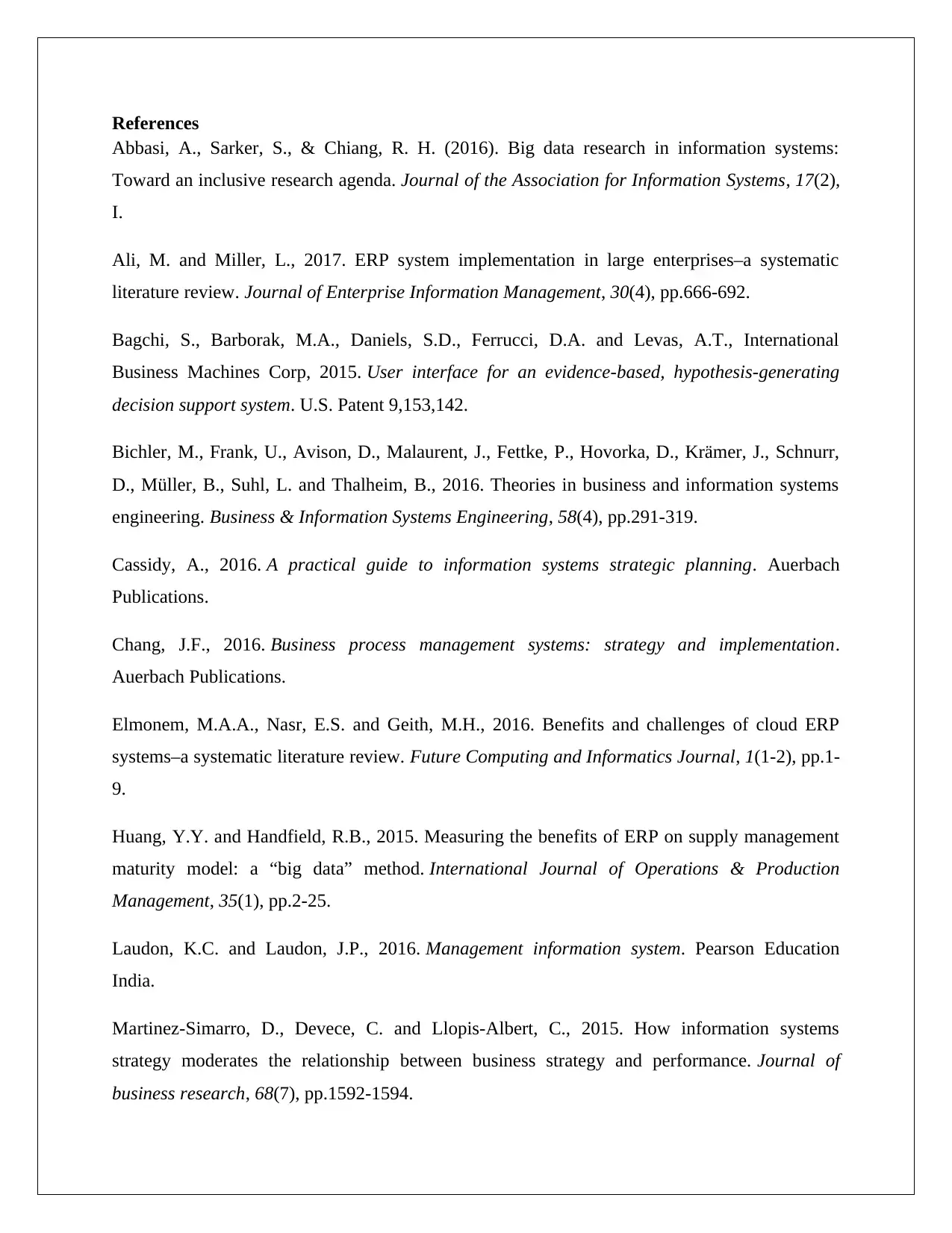
References
Abbasi, A., Sarker, S., & Chiang, R. H. (2016). Big data research in information systems:
Toward an inclusive research agenda. Journal of the Association for Information Systems, 17(2),
I.
Ali, M. and Miller, L., 2017. ERP system implementation in large enterprises–a systematic
literature review. Journal of Enterprise Information Management, 30(4), pp.666-692.
Bagchi, S., Barborak, M.A., Daniels, S.D., Ferrucci, D.A. and Levas, A.T., International
Business Machines Corp, 2015. User interface for an evidence-based, hypothesis-generating
decision support system. U.S. Patent 9,153,142.
Bichler, M., Frank, U., Avison, D., Malaurent, J., Fettke, P., Hovorka, D., Krämer, J., Schnurr,
D., Müller, B., Suhl, L. and Thalheim, B., 2016. Theories in business and information systems
engineering. Business & Information Systems Engineering, 58(4), pp.291-319.
Cassidy, A., 2016. A practical guide to information systems strategic planning. Auerbach
Publications.
Chang, J.F., 2016. Business process management systems: strategy and implementation.
Auerbach Publications.
Elmonem, M.A.A., Nasr, E.S. and Geith, M.H., 2016. Benefits and challenges of cloud ERP
systems–a systematic literature review. Future Computing and Informatics Journal, 1(1-2), pp.1-
9.
Huang, Y.Y. and Handfield, R.B., 2015. Measuring the benefits of ERP on supply management
maturity model: a “big data” method. International Journal of Operations & Production
Management, 35(1), pp.2-25.
Laudon, K.C. and Laudon, J.P., 2016. Management information system. Pearson Education
India.
Martinez-Simarro, D., Devece, C. and Llopis-Albert, C., 2015. How information systems
strategy moderates the relationship between business strategy and performance. Journal of
business research, 68(7), pp.1592-1594.
Abbasi, A., Sarker, S., & Chiang, R. H. (2016). Big data research in information systems:
Toward an inclusive research agenda. Journal of the Association for Information Systems, 17(2),
I.
Ali, M. and Miller, L., 2017. ERP system implementation in large enterprises–a systematic
literature review. Journal of Enterprise Information Management, 30(4), pp.666-692.
Bagchi, S., Barborak, M.A., Daniels, S.D., Ferrucci, D.A. and Levas, A.T., International
Business Machines Corp, 2015. User interface for an evidence-based, hypothesis-generating
decision support system. U.S. Patent 9,153,142.
Bichler, M., Frank, U., Avison, D., Malaurent, J., Fettke, P., Hovorka, D., Krämer, J., Schnurr,
D., Müller, B., Suhl, L. and Thalheim, B., 2016. Theories in business and information systems
engineering. Business & Information Systems Engineering, 58(4), pp.291-319.
Cassidy, A., 2016. A practical guide to information systems strategic planning. Auerbach
Publications.
Chang, J.F., 2016. Business process management systems: strategy and implementation.
Auerbach Publications.
Elmonem, M.A.A., Nasr, E.S. and Geith, M.H., 2016. Benefits and challenges of cloud ERP
systems–a systematic literature review. Future Computing and Informatics Journal, 1(1-2), pp.1-
9.
Huang, Y.Y. and Handfield, R.B., 2015. Measuring the benefits of ERP on supply management
maturity model: a “big data” method. International Journal of Operations & Production
Management, 35(1), pp.2-25.
Laudon, K.C. and Laudon, J.P., 2016. Management information system. Pearson Education
India.
Martinez-Simarro, D., Devece, C. and Llopis-Albert, C., 2015. How information systems
strategy moderates the relationship between business strategy and performance. Journal of
business research, 68(7), pp.1592-1594.
Paraphrase This Document
Need a fresh take? Get an instant paraphrase of this document with our AI Paraphraser
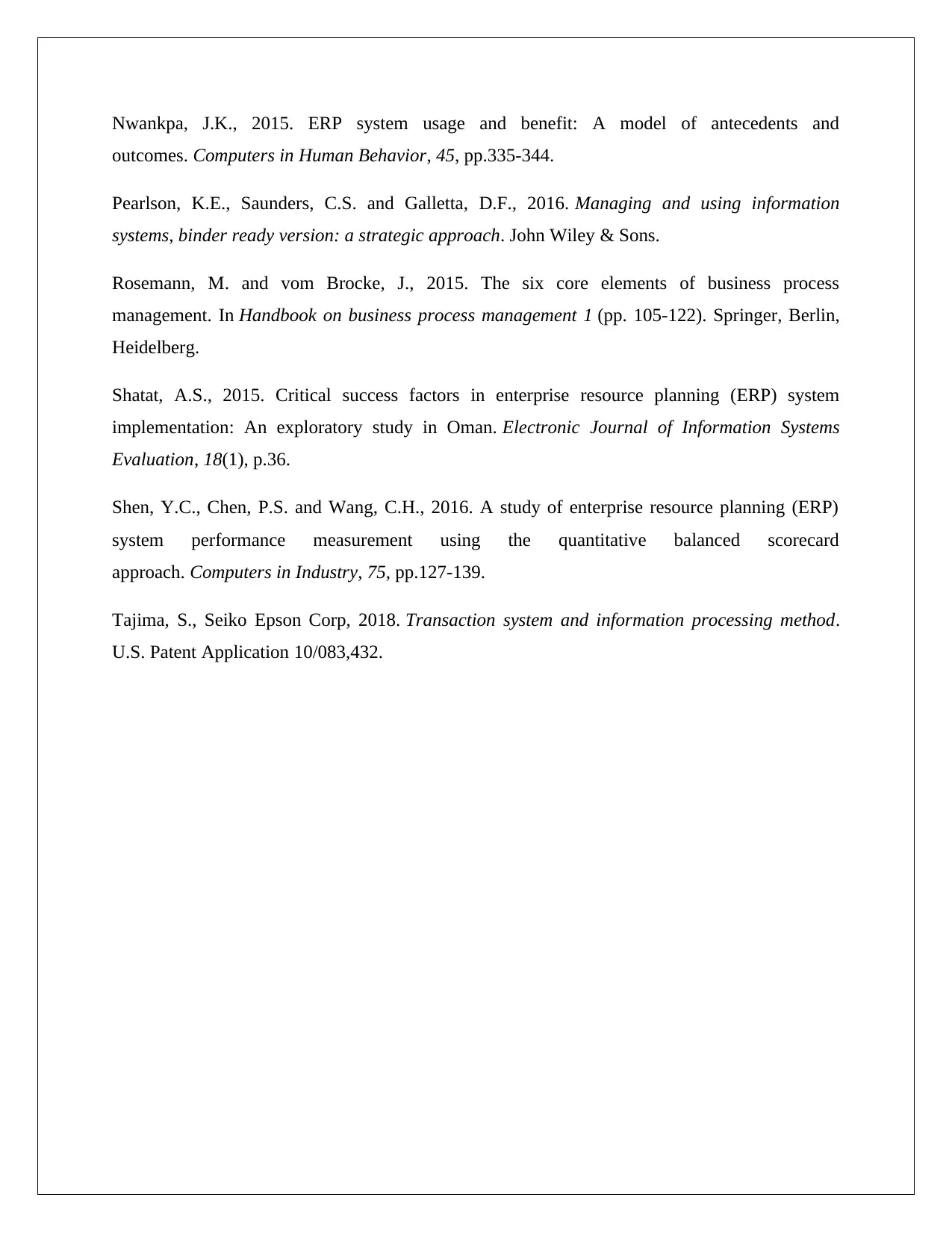
Nwankpa, J.K., 2015. ERP system usage and benefit: A model of antecedents and
outcomes. Computers in Human Behavior, 45, pp.335-344.
Pearlson, K.E., Saunders, C.S. and Galletta, D.F., 2016. Managing and using information
systems, binder ready version: a strategic approach. John Wiley & Sons.
Rosemann, M. and vom Brocke, J., 2015. The six core elements of business process
management. In Handbook on business process management 1 (pp. 105-122). Springer, Berlin,
Heidelberg.
Shatat, A.S., 2015. Critical success factors in enterprise resource planning (ERP) system
implementation: An exploratory study in Oman. Electronic Journal of Information Systems
Evaluation, 18(1), p.36.
Shen, Y.C., Chen, P.S. and Wang, C.H., 2016. A study of enterprise resource planning (ERP)
system performance measurement using the quantitative balanced scorecard
approach. Computers in Industry, 75, pp.127-139.
Tajima, S., Seiko Epson Corp, 2018. Transaction system and information processing method.
U.S. Patent Application 10/083,432.
outcomes. Computers in Human Behavior, 45, pp.335-344.
Pearlson, K.E., Saunders, C.S. and Galletta, D.F., 2016. Managing and using information
systems, binder ready version: a strategic approach. John Wiley & Sons.
Rosemann, M. and vom Brocke, J., 2015. The six core elements of business process
management. In Handbook on business process management 1 (pp. 105-122). Springer, Berlin,
Heidelberg.
Shatat, A.S., 2015. Critical success factors in enterprise resource planning (ERP) system
implementation: An exploratory study in Oman. Electronic Journal of Information Systems
Evaluation, 18(1), p.36.
Shen, Y.C., Chen, P.S. and Wang, C.H., 2016. A study of enterprise resource planning (ERP)
system performance measurement using the quantitative balanced scorecard
approach. Computers in Industry, 75, pp.127-139.
Tajima, S., Seiko Epson Corp, 2018. Transaction system and information processing method.
U.S. Patent Application 10/083,432.
1 out of 11
Related Documents
Your All-in-One AI-Powered Toolkit for Academic Success.
+13062052269
info@desklib.com
Available 24*7 on WhatsApp / Email
![[object Object]](/_next/static/media/star-bottom.7253800d.svg)
Unlock your academic potential
Copyright © 2020–2025 A2Z Services. All Rights Reserved. Developed and managed by ZUCOL.





